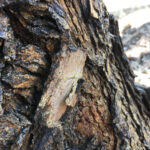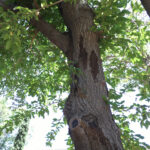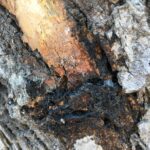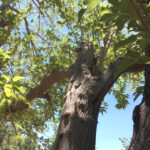Q.Can This Fruitless Mulberry Be Saved?
I moved into a home in late 2017 with a healthy but old (40+) fruitless Mulberry tree. Last year there were bare branch ends here and there (roughly 1/3 of the tree). This year the same has occurred but most of the leaves are also undersized (small but otherwise). However, the tree is now oozing sap and appears to have portions of the bark loosened. I tried to examine the photos I took but other than a yellowy substance (fungus?) I don’t see any specific signs of boring insects or the like. Is the tree drought-damaged (California), sick or both? What can I do to treat this tree in the hope of saving it? I don’t know if this will help identify the problem but here is some additional background: The tree is located in Zone 9 in proximity to Angeles National Forest (CA). The tree is located over the drain field ofa septic system but (somehow) has not caused any problem to the operation of the septic system (I mention this only because I don’t know if something in the septic system could be killing off the tree?). The tree has not received any supplemental watering (my mistake as a new homeowner). This past winter was mild with only half the normal rainfall so the tree is likely also drought stressed (I’ve begun watering it). And finally, the tree was subjected three years ago to bad, out-of-season pruning. This left one of the major (12″) limbs at the center of the tree cut in a “flat top” fashion, and since then a vertical crack is visible in the middle upper portion of the tree (last attached photo shows a 10″ split going down a main limb that descends into the trunk from which I fear there could have been moisture or disease entry). I would like to save the tree if possible and would like to know specifically what treatments to purchase and apply.

Certified GKH Gardening Expert
I see a bacterial infection, then I see slime mold feeding on the bacteria. The bacterial infection will, usually, resolve on its own. You can help by feeding the tree. A slow release, all-purpose fertilizer can help.
Because of the tree's age and size, some of the larger branches could die off. This could lead to a hazard if these limbs are over structures or where people hang out.
I would have your local extension, tree service, or co-op help with any branch removal. Pruning large trees can be a big task to take on.
Here are some articles that will help:
https://www.gardeningknowhow.com/ornamental/trees/tgen/wetwood-bleeding-trees.htm
Trees in this shape are best removed, in my experience. Removing them a little at a time gets expensive, and sometimes it is best to get it done in one go, instead of many sessions. This article will offer more information on tree removal:





